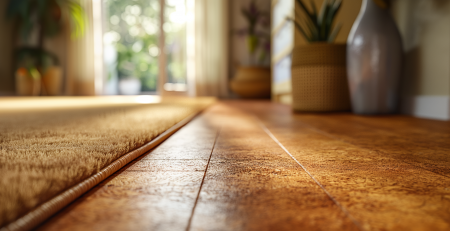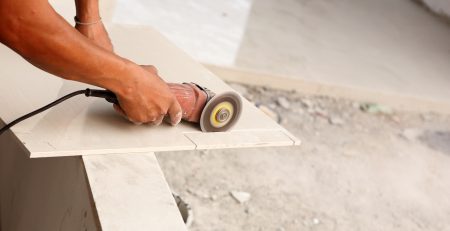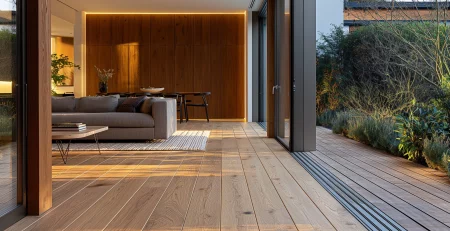Optimise Comfort: What Is The Most Efficient Way To Use Underfloor Heating
Underfloor heating stands out as a superior solution in the quest for a more comfortable and energy-efficient home. By providing even heat distribution and reducing energy consumption, underfloor heating enhances the comfort of any living space and aligns with eco-friendly practices.
This post delves into the various facets of underfloor heating, from installation considerations to the latest smart control technologies, offering homeowners a comprehensive guide to optimising their heating systems. We will explore how this modern amenity can transform your home environment, making it more sustainable, efficient, and comfortable.
Efficiency and Cost-Effectiveness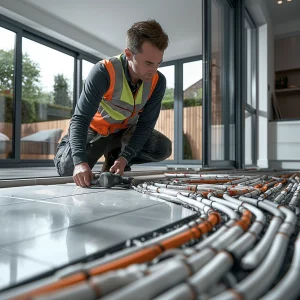
Underfloor heating, a modern and increasingly popular solution for home heating, brings together the dual benefits of efficiency and cost-effectiveness. Unlike traditional radiators that heat a room unevenly, underfloor heating systems distribute heat uniformly, thus providing consistent warmth from the floor upwards and eliminating cold spots. This method of heating not only increases the comfort level within a home and proves to be economically advantageous. Studies suggest that homes equipped with underfloor heating can achieve energy savings of 15-40% compared to conventional radiators. Such a significant reduction in energy use is good for your wallet, with monthly energy costs ranging approximately between £7 and £15, and for the environment.
The financial benefits extend beyond mere operational savings. The reliability and low maintenance requirements of underfloor heating systems further add to their appeal, enhancing the overall value of a property. Unlike radiators that may require bleeding or repair due to leaks or rust, underfloor systems, once installed, need minimal upkeep. This durability contributes to long-term savings and appeals to prospective home buyers, making it a wise investment for future property value enhancement.
Heat Distribution and Environmental Impact
In our continued effort to support sustainable living, discussing the environmental impacts of our chosen heating solutions is imperative. Underfloor heating offers more than just warmth; it contributes to environmental conservation. By maintaining a balance in air temperature and supporting various floor coverings from tile to wood, these systems help reduce the overall carbon footprint of a household. Since underfloor heating operates at a lower temperature while still achieving the same level of warmth as higher temperature systems, it uses less energy, thus reducing carbon emissions.
Moreover, the health benefits cannot be overlooked. Traditional heating systems often circulate dust and allergens throughout the home, posing problems for allergy sufferers. However, underfloor heating minimises air movement and, thus, the circulation of dust, creating a healthier living environment. This is particularly beneficial during the colder months when individuals spend more time indoors, as it significantly reduces the risk of respiratory problems associated with poor indoor air quality.
Types and Installation Flexibility
Underfloor heating systems come in various forms, each suited to different needs and installation scenarios. The two primary types are electric and wet (hydronic) systems. Electric systems are ideal for renovations and new builds; they are often available as sticky mats that can be easily installed under floor coverings. This flexibility makes electric underfloor heating a popular choice for DIY enthusiasts looking to enhance the comfort of their homes without engaging in extensive or invasive construction work.
On the other hand, wet systems are generally recommended for new constructions and involve circulating warm water through pipes under the floor. This type of installation is particularly suited for larger areas like bathrooms and conservatories where consistent heat distribution is crucial. Although installing a wet system is more complex and usually requires professional involvement, its long-term energy efficiency and heat distribution benefits make it a worthwhile consideration.
“Proper installation of underfloor heating systems—electric or hydronic—is pivotal to their efficiency and longevity. Ensuring an even distribution of the mats or cables is crucial for electric systems. In contrast, for hydronic systems, it’s essential to maintain the correct flow and return temperatures to optimise heat output. Engaging a professional from the start guarantees correct installation and maximises the system’s potential, reducing future maintenance issues and costs,” explains Charles Mitten of Mittens Underfloor Heating London.
System Management and Smart Control
Advancements in technology have significantly enhanced the functionality and user-friendliness of underfloor heating systems. Programmable smart thermostats are now an integral part of these systems, allowing homeowners precise control over their heating. These smart thermostats can be operated via apps or voice commands, enabling users to adjust settings remotely or set up zone-specific controls. This not only ensures optimal comfort but also helps in managing energy usage more efficiently.
The underfloor heating system should remain continuously operational during the colder months for optimal efficiency. This constant operation avoids the energy-intensive process of returning the system to temperature if turned off. Manifold settings and individual loop control can be adjusted to accommodate different floor types and room sizes, ensuring that each home area receives just the right amount of heat.
Thermostat Utilisation and Energy Conservation
Effective management of underfloor heating systems through advanced thermostat settings plays a crucial role in maximising energy efficiency and reducing operational costs. Integrating both timer and temperature controls, these thermostats allow homeowners to create heating schedules that align with their daily routines, thereby avoiding unnecessary heating when the house is empty. The optimal configuration typically involves setting lower temperatures overnight and adjusting to around 20°C during the day, which is comfortable yet energy-efficient.
Utilising features like night setback can significantly enhance this efficiency. This feature reduces the temperature during hours of low activity but avoids the energy waste of completely cooling down and reheating the space. By slightly lowering the heat, we can maintain a balance that feels right and is economical. This method not only conserves energy but also extends the heating system’s life by preventing it from operating at full capacity continuously.
Moreover, controlling zones separately can lead to substantial energy savings. By heating only the areas of the home that are in use, we can minimise wasteful heating, ensuring that every kilowatt of energy is used effectively. This zone control not only tailors the comfort to individual preferences but also adapts to each house’s unique layout and usage patterns, making it a smart choice for diverse living spaces.
Installation Considerations and Advantages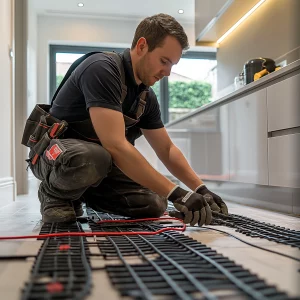
When considering installing an underfloor heating system, several factors must be considered to ensure optimal performance and compatibility with the building structure. The impact of the substrate is one such critical consideration; different materials, such as timber or concrete, have varying responses to heat, which affects the system’s efficiency and the distribution of warmth. Proper insulation is also vital; it prevents heat loss, directing the warmth upwards into the living space rather than letting it dissipate into the ground.
Additionally, assessing the output needs based on room size and window areas is essential for choosing the right system to deliver adequate warmth without excessive energy consumption. While these considerations may seem daunting, they are fundamental to balancing comfort and efficiency.
The aesthetic and practical advantages of underfloor heating also contribute to its growing popularity. Since the system is entirely hidden, it frees up wall space that radiators would otherwise occupy, allowing for more flexible interior design options. This can be particularly beneficial in modern homes where space is at a premium and the clean lines of a minimalist design are desired. Furthermore, the absence of visible heating elements creates a safer environment with fewer surfaces to collect dust, thus maintaining cleaner indoor air.
Future and Innovation
Looking to the future, the potential for innovation in underfloor heating technology is vast. Continued advancements in control technology promise even more precise and user-friendly systems. The integration of underfloor heating with smart home systems is an exciting frontier. This integration not only enhances usability but also opens up new possibilities for energy conservation. The system can automatically adjust its output by connecting the heating system to other smart home devices, such as sensors that detect occupancy and ambient temperature, reducing energy consumption while maintaining optimal comfort levels.
These innovations are not merely theoretical but are already being implemented in many homes across the globe, transforming the way we think about and interact with our living spaces. As technology evolves, so too does our ability to create environments that are comfortable, sustainable, and responsive to our needs.
As we continue to explore and adopt these technologies, our homes become more comfortable and efficient a testament to our commitment to sustainability and innovation.


